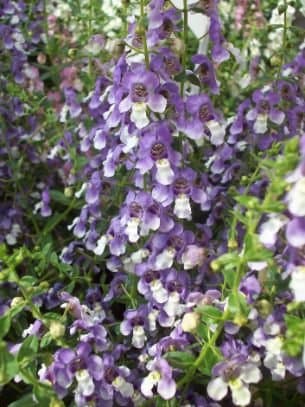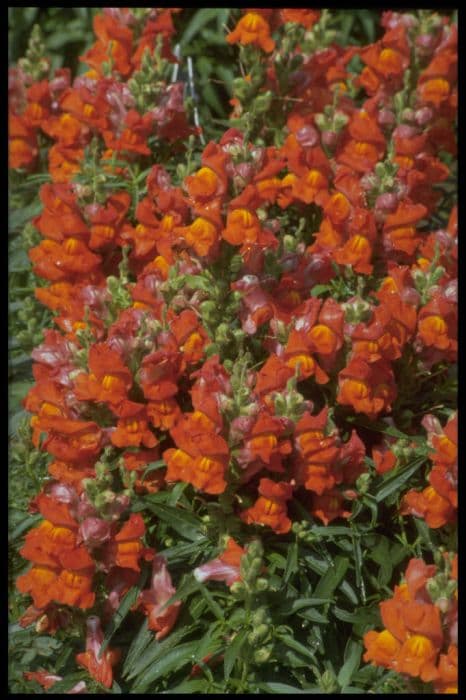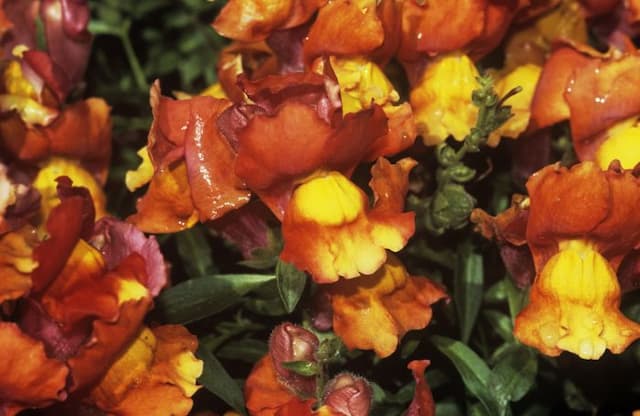Hebe Midsummer Beauty Hebe 'Midsummer Beauty'

ABOUT
The Hebe 'Midsummer Beauty' is a lush plant characterized by its striking foliage and eye-catching flowers. This evergreen shrub boasts glossy, spear-shaped leaves that are arranged neatly along its stems. The leaves often exhibit a dark green coloration, creating a verdant backdrop throughout the year. As its name suggests, the 'Midsummer Beauty' comes into its glory during the summer months, when it produces abundant spires of blossoms. The flowers of the 'Midsummer Beauty' are a particular highlight, forming elongated spikes above the foliage. The tiny individual blossoms crowd together on these spikes and are typically a pale lilac or soft violet hue, adding a touch of elegant color to any garden setting. Once the plant is in full bloom, it's a magnet for bees and butterflies, which are attracted to the nectar-rich flowers. Overall, the Hebe 'Midsummer Beauty' is cherished for its ornamental leaves and decorative blooms, which provide visual interest and a burst of summer color. Its evergreen nature ensures that it remains a prominent feature in the garden throughout the year, contributing texture and greenery even outside of its flowering period.
About this plant
 Names
NamesFamily
Plantaginaceae.
Synonyms
Hebe 'Midsummer Beauty', Shrubby Veronica, Summer Beauty Hebe.
Common names
Hebe 'Midsummer Beauty'.
 Toxicity
ToxicityTo humans
The Hebe plant is generally not considered highly toxic to humans. However, it may cause mild stomach upset if ingested in large quantities. It's always a good idea to exercise caution and prevent ingestion, especially with children, as individual sensitivity to plants can vary.
To pets
The Hebe plant is also not considered highly toxic to pets. However, as with humans, it may cause mild gastrointestinal upset if your pets consume parts of the plant. Symptoms could include vomiting and diarrhea. It's best to keep an eye on your pets and prevent them from ingesting the plant, and consult a veterinarian if you suspect your pet has eaten a large amount or is showing signs of distress.
 Characteristics
CharacteristicsLife cycle
Perennials
Foliage type
Evergreen
Color of leaves
Green
Flower color
Lilac
Height
5 feet (1.5 meters)
Spread
5 feet (1.5 meters)
Plant type
Shrub
Hardiness zones
8
Native area
New Zealand
Benefits
 General Benefits
General Benefits- Attractive Foliage: Hebe 'Midsummer Beauty' has glossy, green leaves that provide year-round interest.
- Long Flowering Period: It produces spikes of lilac-purple flowers which bloom from summer into autumn, offering a long season of visual appeal.
- Wildlife Friendly: The blossoms attract pollinators like bees and butterflies, benefiting the local ecosystem.
- Low Maintenance: It is known to require minimal upkeep once established, making it suitable for gardeners of all skill levels.
- Drought Tolerance: Once established, it has a degree of drought resistance, which is particularly beneficial in areas with water restrictions.
- Compact Growth: This cultivar maintains a neat, compact shape that is ideal for borders, containers, or small gardens.
- Versatility: It can be used for a variety of gardening designs, including formal borders, rock gardens, and coastal gardens.
- Hardy: It is relatively hardy and can tolerate a range of conditions, though it prefers well-drained soil and a sunny to partly shaded position.
 Medical Properties
Medical PropertiesThis plant is not used for medical purposes.
 Air-purifying Qualities
Air-purifying QualitiesThis plant is not specifically known for air purifying qualities.
 Other Uses
Other Uses- Wildlife Attraction: Hebe 'Midsummer Beauty' can be grown to attract butterflies, providing a nectar source for these pollinators and adding vibrancy to the garden ecosystem.
- Privacy Screening: This plant can be used as a living privacy screen in gardens due to its bushy growth habit, creating a natural green barrier between properties.
- Erosion Control: Its dense root system helps stabilize slopes and banks, preventing soil erosion in areas prone to losing topsoil during heavy rains.
- Thematic Gardens: Hebe 'Midsummer Beauty' can be utilized in maritime or coastal-themed gardens to reflect the plant's natural resistance to salty breezes and coastal conditions.
- Educational Tool: Botanical gardens use this plant to educate visitors about biodiversity and the importance of plant conservation.
- Photography Backdrop: The long flowering period and attractive appearance of Hebe 'Midsummer Beauty' make it an excellent backdrop for garden photographers.
- Winter Interest: With evergreen foliage, it provides color and structure to otherwise barren winter landscapes.
- Pollution Tolerance: This plant can be used in urban gardens to mitigate the visual impact of pollution and provide a touch of nature in city settings.
- Floral Arrangements: Although not a traditional cut flower, Hebe 'Midsummer Beauty' can be used in informal floral arrangements to add greenery and subtle blooms.
- Feng Shui Gardens: Some believe that incorporating Hebe 'Midsummer Beauty' into a garden can enhance the garden's chi, as its evergreen nature represents life and vitality in Feng Shui practice.
Interesting Facts
 Feng Shui
Feng ShuiThe Hebe is not used in Feng Shui practice.
 Zodiac Sign Compitability
Zodiac Sign CompitabilityThe Hebe is not used in astrology practice.
 Plant Symbolism
Plant Symbolism- Youth and Vitality: Hebe, the genus of this plant, is named after the Greek goddess of youth, suggesting that the 'Midsummer Beauty' represents freshness, rejuvenation, and energy typically associated with the young.
- Nurturing: Since it is a plant that persists in blooming even in the midsummer heat, it symbolizes care and sustenance.
- Endurance: 'Midsummer Beauty' blooms during the height of summer, representing the ability to thrive and endure through tough conditions.
- Beauty: As suggested by its name, the plant is often associated with attractiveness and aesthetic appeal, embodying the peak of summer beauty.
 Water
WaterThe Hebe 'Midsummer Beauty', commonly known as the Summer Beauty hebe, should be watered deeply and infrequently to encourage a robust root system. It's ideal to water the plant once a week, providing about one gallon of water per session, depending on weather conditions. During hot and dry periods, you may need to increase watering to twice a week, but always check the soil moisture first; it should be slightly moist but not soggy. Reduce watering in the winter when the plant is dormant. Overwatering or poorly draining soil can lead to root rot, so ensure proper drainage.
 Light
LightThe Summer Beauty hebe thrives best in full sun to partial shade conditions. The ideal spot for this plant is where it can receive at least six hours of direct sunlight daily with some afternoon shade in extremely hot climates. Avoid deep shade as it can lead to sparse foliage and fewer flowers.
 Temperature
TemperatureThe Summer Beauty hebe prefers cool to moderate temperature conditions and is hardy in USDA zones 7-10. It can tolerate temperatures as low as 10°F but thrives best in environments where the temperature ranges from 50°F to 70°F. Be cautious of extreme heat, especially if the plant is in a full sun location, as this can stress the plant.
 Pruning
PruningPruning the Summer Beauty hebe is important to maintain its shape, encourage bushier growth, and remove any dead or damaged branches. The best time for pruning is in the spring after the last frost or after flowering to avoid cutting off future blooms. Prune lightly, about once a year, just to shape the plant and reduce any overly long stems that spoil the bushy form.
 Cleaning
CleaningAs needed
 Soil
SoilThe best soil mix for Hebe 'Midsummer Beauty' is well-draining soil with added horticultural grit or perlite to improve drainage. The soil should be fertile with plenty of organic matter. The preferred soil pH for this shrub is slightly acidic to neutral, ranging from about 6.5 to 7.5.
 Repotting
RepottingHebe 'Midsummer Beauty' should be repotted every 2-3 years or when it becomes root-bound. It is best to repot in the spring using fresh soil and a slightly larger pot to give it room to grow.
 Humidity & Misting
Humidity & MistingHebe 'Midsummer Beauty' prefers moderate to high humidity levels. Providing humidity levels between 50-60% will help keep the foliage healthy and reduce stress on the plant.
 Suitable locations
Suitable locationsIndoor
Ensure bright light, moderate humidity, and good airflow for Hebe indoors.
Outdoor
Plant in sunny spot, shelter from harsh winds, well-draining soil.
Hardiness zone
8-10 USDA
 Life cycle
Life cycleHebe 'Midsummer Beauties' begin their life cycle with seed germination, requiring a well-draining soil medium and appropriate warmth and moisture. After germination, seedlings emerge and enter a juvenile vegetative stage, focusing on root and foliage growth with their characteristic glossy, lance-shaped leaves. As plants mature, they enter the adult vegetative stage marked by the development of woody stems and increased leaf production, preparing for the reproductive phase. The flowering stage usually occurs in the summer months, displaying its long racemes of purple or violet flowers that attract pollinators. Post-pollination, if conditions allow, seeds are produced and dispersed, either by wind or fauna, initiating a new generation. Once the flowering season concludes, the plant enters a period of dormancy during colder months, especially in temperate climates, which allows it to conserve energy for the following growing season.
 Propogation
PropogationPropogation time
Spring-Early Summer
Propogation: For the Hebe 'Midsummer Beauty', the most popular method of propagation is through semi-hardwood cuttings. This process usually takes place in the late summer or early fall, when the new growth has started to mature and harden slightly. To propagate, a gardener would take a cutting of about 4 to 6 inches (10 to 15 cm) from the current year's growth, ensuring that several leaves are present. The bottom leaves are removed, and the cut end is often dipped in rooting hormone before being placed in a well-draining potting mix. The cutting should then be kept moist and in a warm environment with indirect sunlight until roots develop, which can take several weeks. After rooting, the new Hebe can be transferred to a larger pot or the garden.









